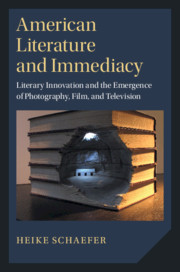 American Literature and Immediacy
American Literature and Immediacy from Part I - Literary Immediacy and Photography
Published online by Cambridge University Press: 19 December 2019
The chapter shows that Emerson and Whitman refined their poetics by probing the truth claims and reality effects of photography. It expands our understanding of American romantic literature by connecting the romantic concern with intuition, firsthand experience, and organic expression to the emergence of photography. Claims to authenticity and immediacy were central to the reform efforts of the transcendentalists because they enabled them to resist social conventions, to counter the commercialization of literary culture, and to renew literature’s democratic ethos. The chapter identifies photographic discourse as an important testing ground for this orientation. Emerson repeatedly reflected on photography to think through the relations between knowledge and mediation and to define the cultural role of literature. At first, he held that the camera’s capacity to record optical reality without distortion realized his ideal of intuitive insight and original expression. His attitude towards photography grew more ambivalent, however, as his commitment to a poetics of process deepened. Seeking to represent a world in flux, Emerson grew wary of photography’s stabilized records of reality.
To save this book to your Kindle, first ensure [email protected] is added to your Approved Personal Document E-mail List under your Personal Document Settings on the Manage Your Content and Devices page of your Amazon account. Then enter the ‘name’ part of your Kindle email address below. Find out more about saving to your Kindle.
Note you can select to save to either the @free.kindle.com or @kindle.com variations. ‘@free.kindle.com’ emails are free but can only be saved to your device when it is connected to wi-fi. ‘@kindle.com’ emails can be delivered even when you are not connected to wi-fi, but note that service fees apply.
Find out more about the Kindle Personal Document Service.
To save content items to your account, please confirm that you agree to abide by our usage policies. If this is the first time you use this feature, you will be asked to authorise Cambridge Core to connect with your account. Find out more about saving content to Dropbox.
To save content items to your account, please confirm that you agree to abide by our usage policies. If this is the first time you use this feature, you will be asked to authorise Cambridge Core to connect with your account. Find out more about saving content to Google Drive.